The Indiana Jones of Stones
Lucia Silvestri, Jewellery Executive Creative Director of the Roman house Bvlgari, admits to being enamoured by the gems and strong colours of India, with which she infuses spectacular pieces…
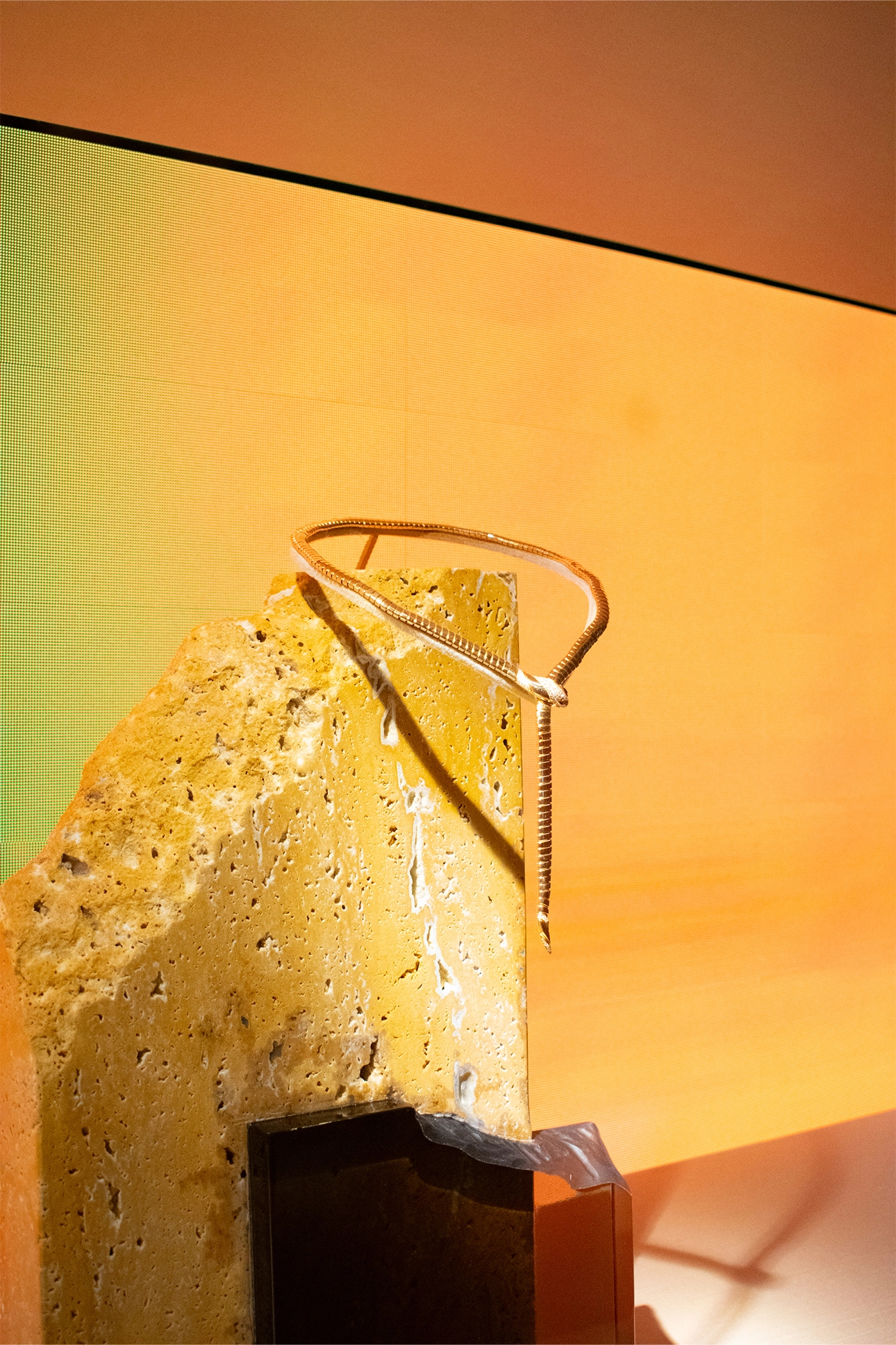
At the very centre of the creative storm that is Bvlgari’s Serpenti Infinito exhibition, was a diminutive lady in a pale trouser suit. She looked unfussed as she went through all the motions. She posed for photographs, she conducted press conferences, she headed panel discussions and she graced the glittering Bvlgari gala, seemingly all in one breath. And in the flurry of all this activity, she spoke to Verve in the conference room where only moments earlier she had held sway over an audience of at least 50 eager “fans”.
I tell her that I feel as if I know her already. Such is the power of the internet which reveals Lucia Silvestri’s backstory for all those who care to search. “Makes my work easier,” she quips. The Executive Creative Director of Roman high jeweller, Bvlgari, I realise, is an industry icon, having gracefully broken barriers in a male dominated industry. She joined Bvlgari as an 18-year-old temporary secretary and today, four decades later, she is at the centre of high-powered events and on the front pages of national newspapers. Back then, it was a view of Paolo Bulgari’s desk, laden with gemstones, that forever transformed this biology student into a lover of stones.
The exhibition — which runs until October 17 — is spread over three floors of the Art House at Mumbai’s Nita Mukesh Ambani Cultural Centre (NMACC). It celebrates Bvlgari’s Serpenti icon through art, culture and craftsmanship, in continuance of the brand’s commemoration of the Chinese Year of the Snake, in its third edition after Shanghai and Seoul. The presentation is divided into three sections: “Crafting Serpents in History” dives into the icon’s significance in Indian mythology; “A Mythic Presence” examines the cultural relevance of the nāga; while “Infinite Transformations” looks at the serpent through a lens of the future. “We [in India] had a very strong oral tradition where we heard a lot of stories from our grandmothers and the snake did feature in a lot of those,” says Aparajita Jain, director and co-founder of Nature Morte which co-curated 23 artists and 53 artworks for the presentation. “But, through my experience of doing the show now — I have fallen in love with it [the serpent]. The truth is, it’s something that is quite magical because it reinvents itself…. It’s almost seductive, the idea of it. I suddenly realised that every kind of civilisation and people have their own understanding of the snake…. So I think that it’s a whole world to explore through the lens of the serpent.”
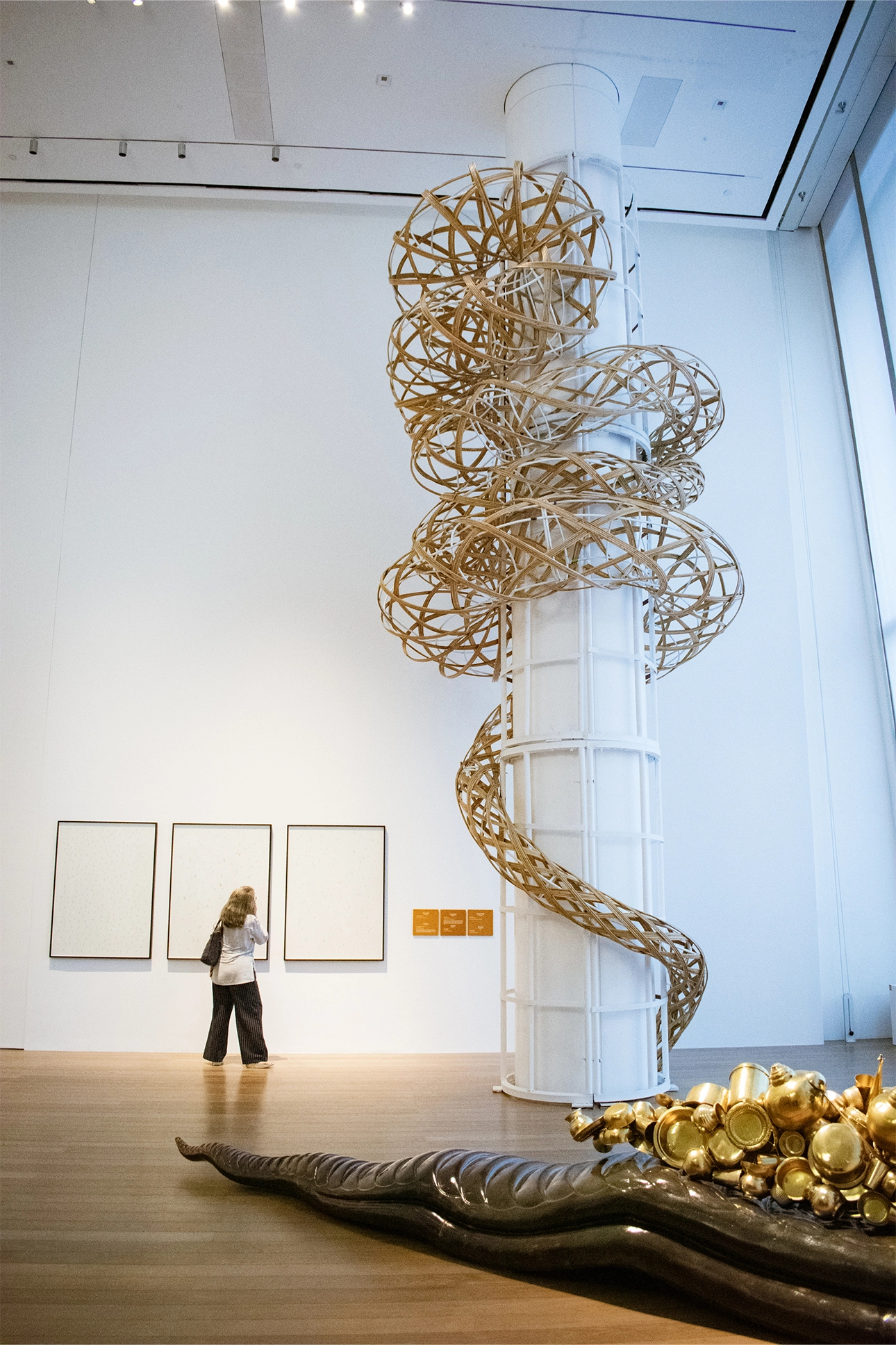
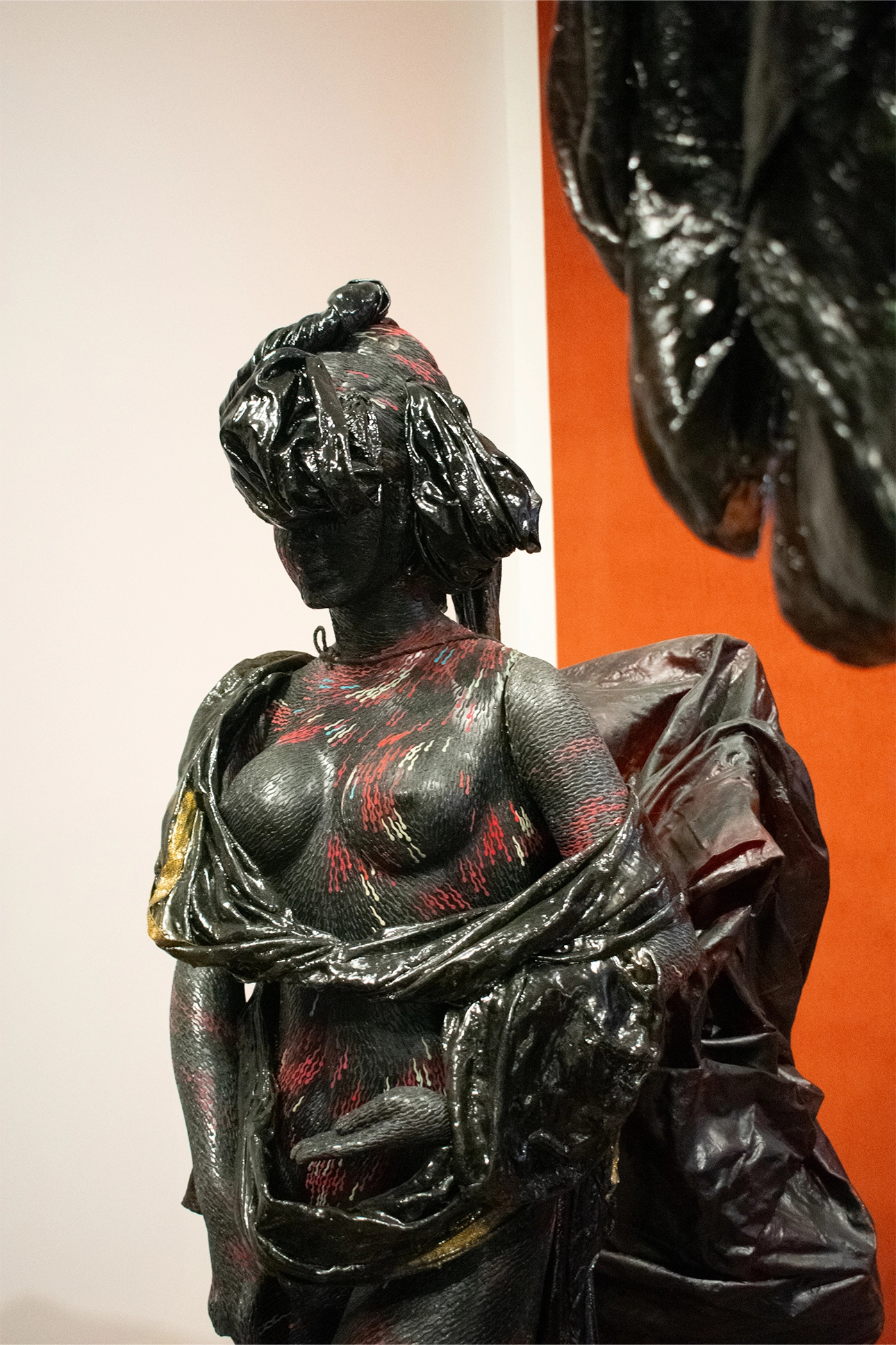
Certain pieces stood out for their sheer visual impact like Bharti Kher’s Medusa (2025), a towering figure referencing Greek mythology created from saris covered in resin; Subodh Gupta’s Infinite Sleeper (2025), a sculpture incorporating bronze and brass utensils, that evokes “Ananta Shesha”; Enter Projects’ Rattan Snake (2025), an architectural installation inspired by the reptile’s body. Other exhibits bring awareness to the spectacular beauty of ancient Indian art, like the 15th century Sapta Nadi Tantric text, where the nāga form signals water and rivers or the 17th century Nag-yash Yantra, a geometric diagram associated with serpent deities. Looking to the future, the immersive AI Data Sculpture by Refik Anadol is a 360° mirrored environment shaped by machine learning algorithms trained on natural snake forms.
Glittering watches, neck pieces, earrings and bracelets bearing the Serpenti motif are spread over each floor, in their glass cases, creating a dialogue between the symbol and India’s nāga tradition. The Roman House’s first Serpenti creation dates back to 1948 with wrist-wrapping jewellery watches. The Bvlgari Heritage collection includes a display of Serpenti Tubogas jewellery watches of the ’60s, a contemporary yellow gold Serpenti belt inspired by a ’70s original and the iconic five-coil Serpenti Pallini bracelet-watch with a diamond-set head, dating back to around 1955.
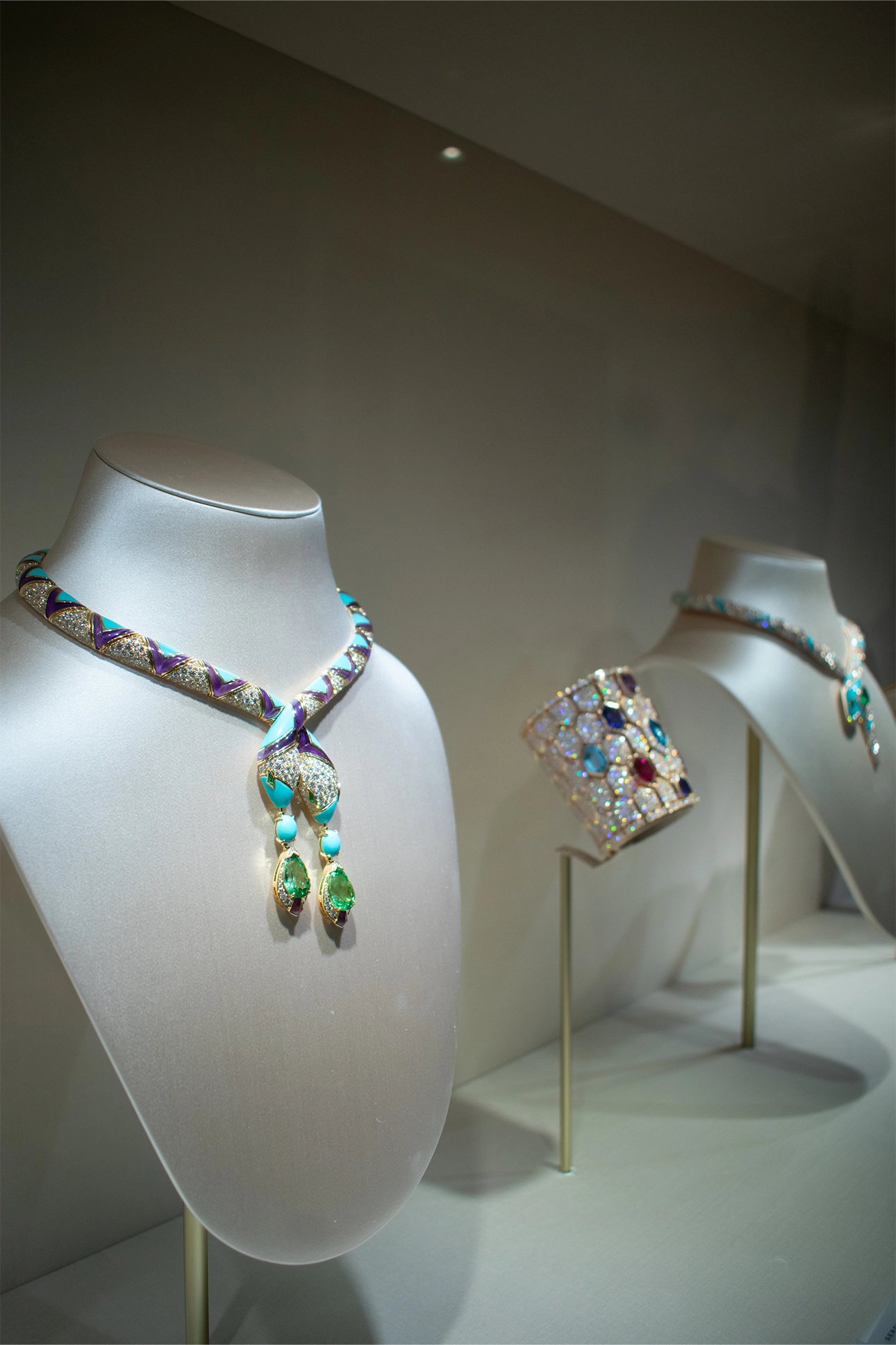
A spectacular fusion of “Roman mastery and Indian mystique”, the Serpenti High Jewellery collection glitters with names like Serpenti Maharani Secret necklace, paying homage to India’s legendary queens. The necklace was worn earlier at the Bvlgari gala by the company’s Global Brand Ambassador, Priyanka Chopra Jonas who has associated with the brand to create Indian pieces like the kada and the mangalsutra. Serpenti Apsaras references mythic Indian beauties; Serpenti Saffron Dew shines in colours of gold and green; Serpenti Divine Monsoon is radiant with tanzanites, green tourmalines, rubies and rose-cut diamonds hung like raindrops. Silvestri admits that until she came to India she was used to “playing with stones of light and pastel colours”. The country made her appreciate “strong colours; the contrast of colours”, and today Bvlgari is considered “a master of colour stones”.
Silvestri is quick to credit that, “everything is teamwork”. But she has long been Bvlgari’s Director of Gems Acquisition, the only person outside the family to be trusted with this responsible position, and her many visits to India, as with other gem-rich countries, stand testimony to this. Her face softens almost to relief as she mentions that she will be leaving Mumbai for Jaipur the day after. It comes as no surprise that the beautiful Rajasthani city is her favourite in India and she values memories of her gemstone sourcing expeditions there even as a girl. With Bvlgari slated to open at least three new jewellery stores in India in the next year, we will certainly be seeing more of this wonderful lady, very soon.
Excerpts from an exclusive interview with Lucia Silvestri….
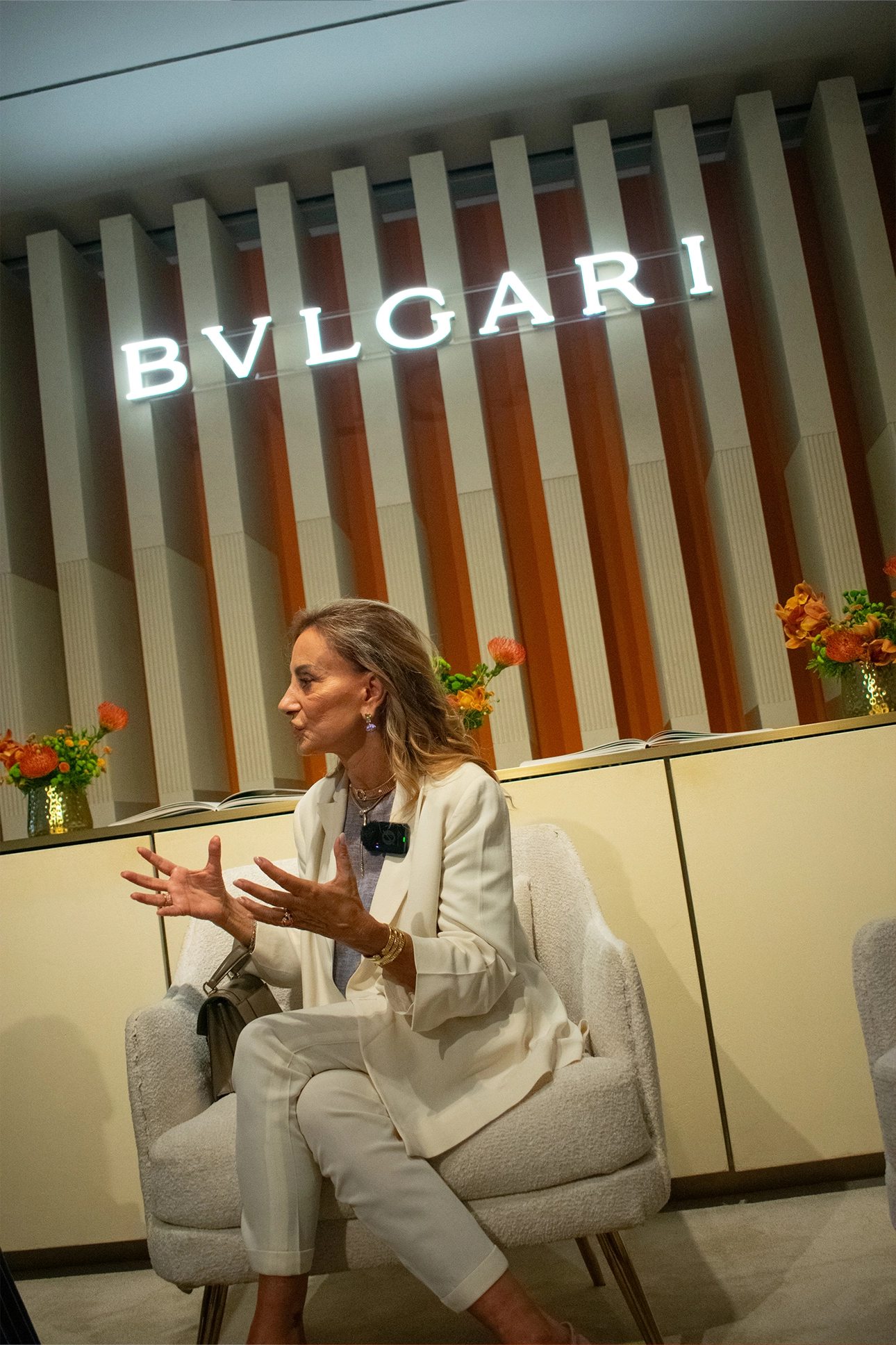
What continues to inspire you about the Serpenti motif? How do you ensure that a 70-year-old symbol remains contemporary and coveted?
Yes, I’m excited every year to create a new shape of Serpenti, while maintaining the DNA of the brand. So if you visited the exhibition, you saw the heritage part, and I could see the parallels between the heritage Serpenti and the contemporary Serpenti. It’s a big challenge for me, for my team, to create a new pattern of the skin of Serpenti or a new head, and maintain the DNA of the brand. Because, of course, everyone can create Serpenti, copying us in some way. But for us, it’s, I don’t want to say that, but it’s natural — we like so much to create a new Serpenti, a new pattern, a new shape, new craftsmanship…. It’s very important also to have more flexibility on the Serpenti and to make it more versatile, to have more wearability. So it’s something that is challenging, but we like to do it very much.
What have your experiences been with serpents in Indian art, architecture or even with live ones? How has India added to your design inspiration?
Your culture, it’s full…. And it’s impressive how many Serpenti you have in your culture — I have been reading books, taking pictures, and visiting India. I can see Serpenti everywhere! So, my way to work has been to take pictures and send them to my team, and request them to please take inspiration from this. And India is one of the best places where we can find different kinds of inspiration.
Has anything been really surprising for you with the Serpenti in India?
I was surprised by this exhibition. Because of the artists who are represented here and have reinterpreted the Serpenti. For me, this was really, really impressive because they can interpret the serpent in a very original way — with colours, with different shapes, different 3-D dimensions. I’m really impressed with this exhibition. So, there are, I think, 23 artists — so many artists that have worked around this symbol — and I found this greatly creative.
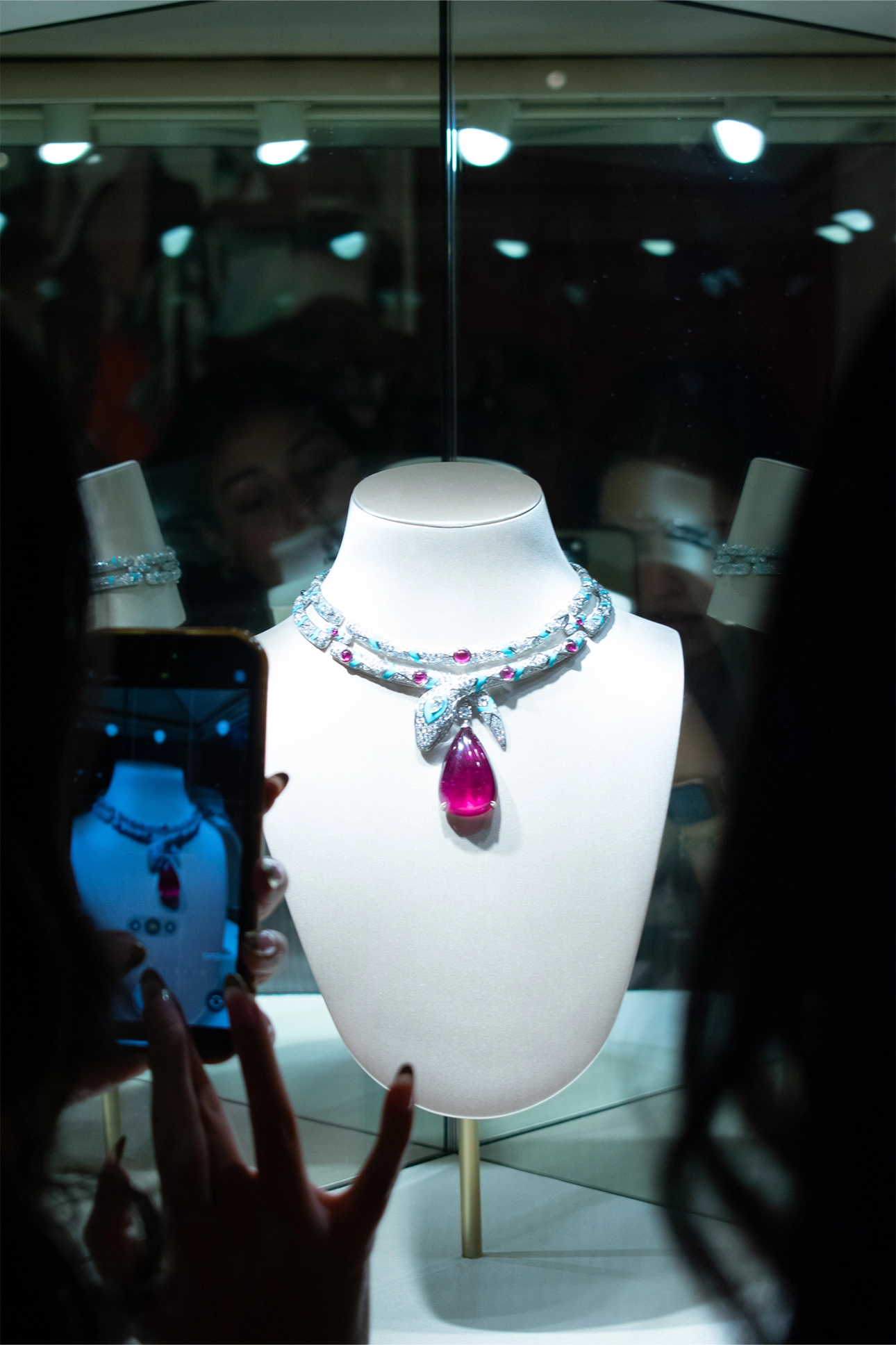
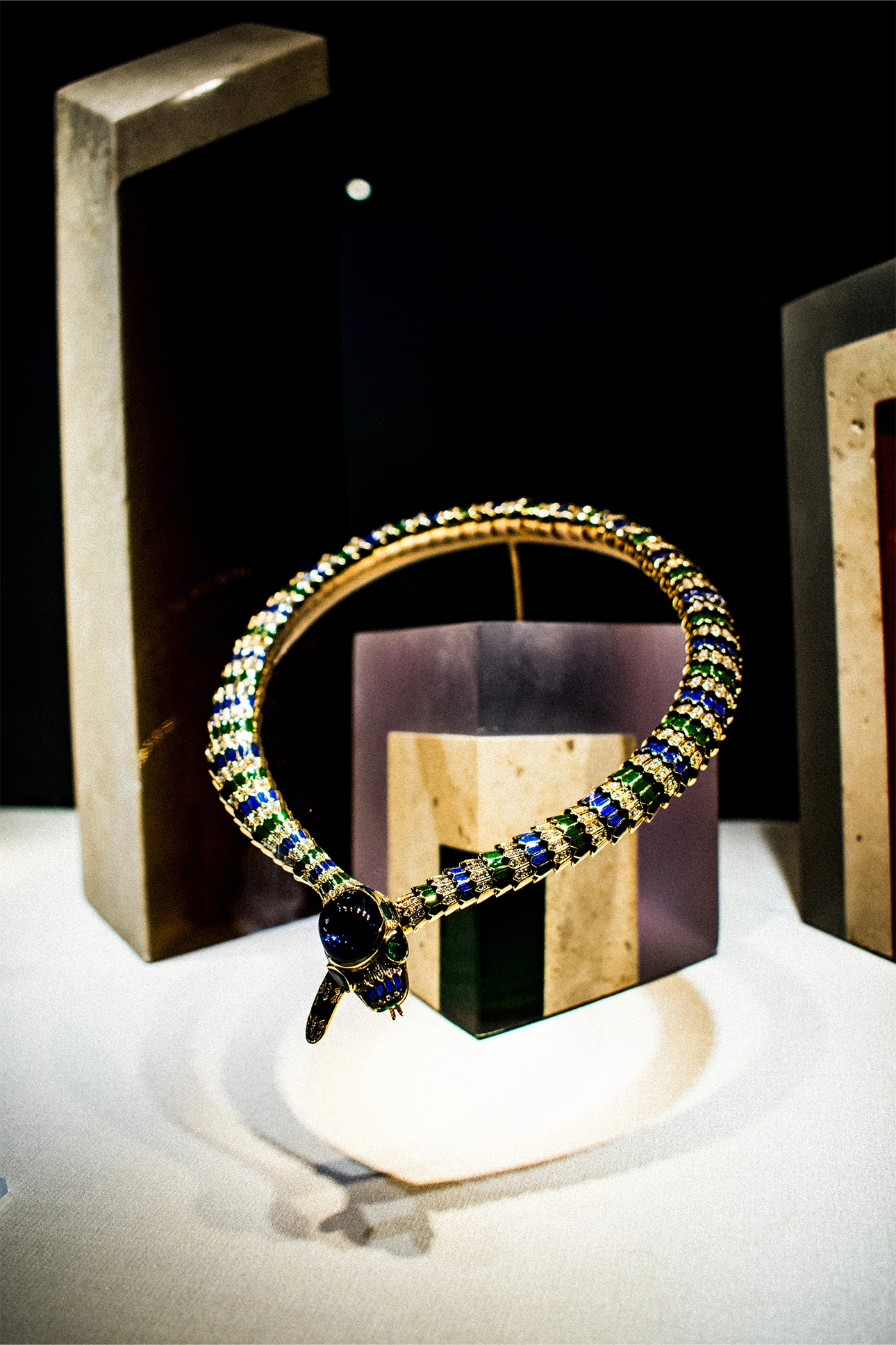
How do you balance designing jewellery with an Indian aesthetic while continuing to keep the Roman spirit alive? This collection does not look like Indian jewellery, right? And yet it’s so strongly inspired by India, as is obvious in the names of the high jewellery pieces like the Serpenti Maharani Secret necklace, among others….
Because of the gems! I buy almost all of the colour gems here in India, in Jaipur…. I’m going tomorrow to Jaipur — and that first inspiration comes from the gems. So India is always in my heart. Of course, I’m Roman, I’m Italian, and the balance is, I don’t want to say, 50 per cent India, because of the gems. This has been the feeling from the beginning, not because of me, but because of the original family. And India, it’s always in our hearts and in every collection there is a touch of India; in every collection that we create.
Not just the latest one?
Yeah because, interesting to know, because of the gems of course, but also because your tradition of jewellery in India is so important. I have studied all the jewels of the Maharajas and Maharanis. Sometimes I feel that in my previous life, maybe, I could have been a Maharani, because I like so much to wear jewels all together. And so, I have a very strong connection with India.
You’ve called yourself the “Indiana Jones of stones”….
Yes….
And you love going to Jaipur….
Yes….
How have your gem-hunting visits to Jaipur inspired your work? Can you relate a memorable incident?
How many hours do you have? Because I have so many angles.... Now, I can talk about a rough that I met — an enormous rough of emeralds — four kilos. It was huge, like a baby. That is really something that I cannot forget in my life. It was in 2019, before COVID-19, okay? And it was really a surprise! I entered this room, and this piece of rough was covered, so I didn’t know what was under it. I took out the cover, and I saw this huge, incredible piece of emerald. And I felt immediately, the energy of nature. Because as I have said before, this is a gift of nature. So full of an incredible energy….
Wow! I didn't know that these were still being discovered! So did you get it?
We didn’t buy it then but I started to dream about it. What can we have from inside of that rough? And I asked for a cabochon, around 100 carats — it was my dream. And at the end they did it, the cutter, the owner of the emeralds, they trusted me, and they said, ‘Okay, we want to follow your dream’. And they cut it to around 93 carats — so close to 100 carats. And we made an incredible serpentine necklace from it….
You've said that you speak to stones like people speak to plants. Is that part of your creative process, or is that a kind of empathy that you have for stones?
Both, because it’s a natural feeling. But sometimes, I have a stone on the table, and I say, ‘What can I do with you?’ And, in some way, I think that the stone answers me. ‘Okay, we can make a ring with you.’ So it’s something that I have in my soul.
It’s part of your DNA…. And it’s amazing that you discovered it at the age of 18….
Yes, I was very lucky, because I was the right person in the right place; with this incredible family that gave me everything professionally speaking. They are my mentors, my teachers…. I spoke with Mr Bulgari earlier and he told me, ‘Ah, you are there. I wanted to be there with you. I remember Rambagh Palace (in Jaipur)!’ So, we have very good memories together.
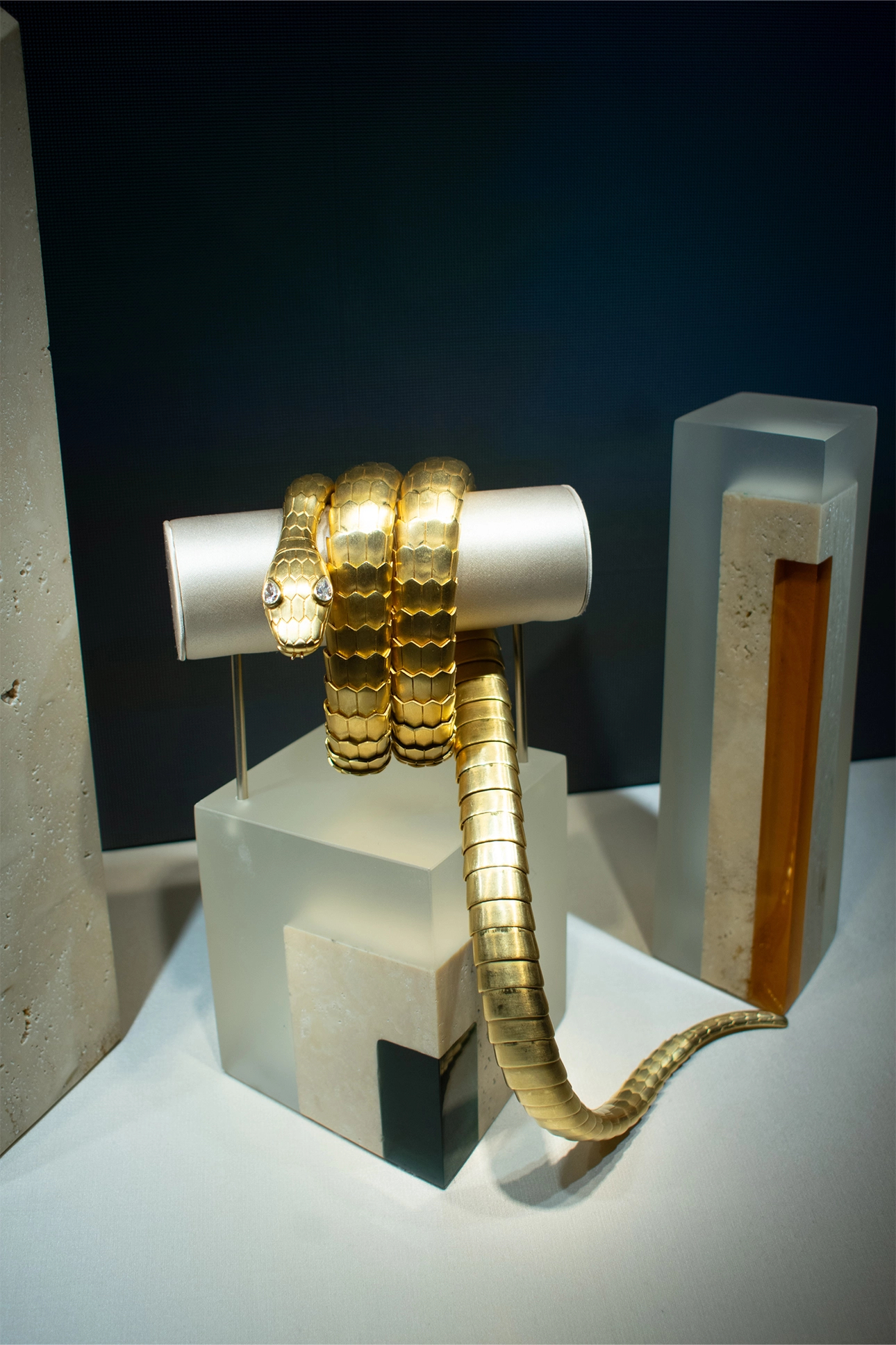
Have you always looked at the Serpenti through the lens of art?
No, no, no…. We don’t look at the Serpenti like art. We look at it as a Bvlgari symbol, right? So we have to think about our heritage. And through our heritage, we maintain this DNA. And so, we play with colours, with gems, but we don’t want to be influenced by other artists —we think about the Bvlgari style.
While India is a source of gems and craftsmanship, historically Bvlgari has never had any Indian celebrity connected to it — until Priyanka Chopra Jonas. How is Bvlgari’s Global Brand Ambassador the quintessential Bvlgari girl?
Priyanka has a strong personality. She is warm. She can wear jewels in the right way. She knows how to wear jewels, because it is in her blood. So for us, it’s important to have a testimonial like her that can wear high jewellery in the perfect way. Last evening, she was amazing with the serpentine necklace, the one with the Rubellite that I bought in Jaipur — in this white dress — she was amazing.
As an icon in a male-dominated industry, what would you say to your followers?
I have a lot of followers from India, on my Instagram, and I have received many questions like, ‘How can I reach your position’, or ‘How can I be a designer? ‘How can I buy gems too?’ Honestly, I don’t know. I can say determination, passion and sacrifice. If you want to reach your goal, if you want to reach your dream, you have to be determined and humble also, and have a lot of passion. The young generation nowadays is not like that. They want to do everything immediately, very quickly, very fast. So I suggest, ‘Be patient, but determined’.
Do you have a personal collection of Serpenti jewellery that you love?
No, I don’t have a collection. From my parents, I received, when I was 18 years old, a Serpenti ring; so I owned my first Serpenti when I was 18 years old.